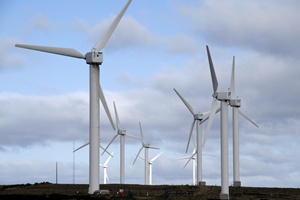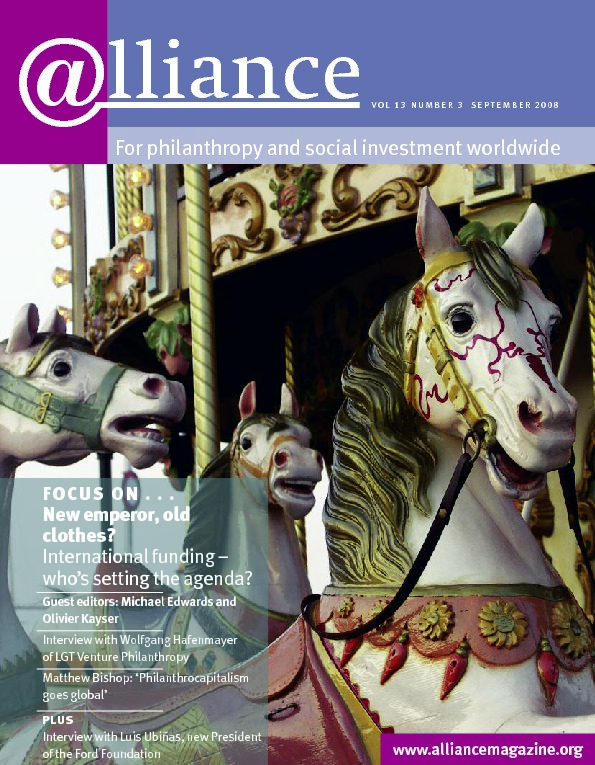Climate change: should non-government funders be doing anything other than advocacy?
While addressing climate change is seemingly on everyone’s agenda, it is less clear what role philanthropy should play, given the vast amounts of money required to address the problem.
Many, including Nobel Laureate Al Gore and Lord Nicholas Stern, have focused on the need for policy change by national governments and international bodies. Believing that only policy change will have a material impact on the problem, many have focused their philanthropic efforts on advocacy – either encouraging or pressuring elected or appointed leaders to take action.
Others, such as Sir Richard Branson and Google.org, have focused much more on private action. Implicitly or explicitly, many in this camp suggest that changing policy takes too long and requires too much compromise. By the time government acts, it will be too late to forestall dramatic climate consequences. The proper role for philanthropy is therefore to kick-start immediate change through innovations like alternative energy.
Where should philanthropic dollars be directed for maximum impact? Tim Ogden
 In favour of advocacy
In favour of advocacy
Now make me do it
George Polk
Climate change is arguably the most expensive and complex challenge that humanity has faced. Since the industrial revolution, we have been building an economy that steadily emits more and more greenhouse gases. Now, all of a sudden, we have to alter virtually every process that we have painstakingly evolved, and we have to do it quickly. Most scientists now agree that it is crucial that we avoid increasing average temperatures by more than 2 °C above pre-industrial levels. What happens when we pass that limit?
There are, as they say, things we know, ‘known unknowns’ and ‘unknown unknowns’. What we know is that weather patterns will change tremendously. We can say for sure that there will be more frequent severe storms, droughts, floods and epidemics. We will no longer be able to count on ‘natural’ weather, water or other cycles and systems to sustain us. Our planet will become unreliable. Then there are the ‘known unknowns’. What happens when the permafrost begins to melt? At what point will oceans stop acting as a carbon sink? And finally there are the ‘unknown unknowns’. Once this roller coaster set of planetary reactions starts, is there any way to stop it?
The challenge
If this sounds daunting, it is. To stay below the 2 °C increase, the generally accepted view is that we need to peak our emissions in the next ten years and then begin an aggressive reduction programme. Given that intensive agriculture and forest degradation and certain other unavoidable processes will continue to produce emissions, this in essence means that by 2050, we have to be living in a world of zero carbon energy, materials and transportation. This requires investments in new energy systems, new basic materials (particularly cement), new efficiency technologies, new urban planning models – and, if we fail at all that (and perhaps even if we succeed), new ways of life and models of eating and living.
The good news is that we can do this, and at a reasonable cost. Everyone from the green NGOs to government think-tanks and respected economists agree that we have the technology and the financial resources to solve the problem. A recent McKinsey analysis (funded partly by philanthropy) concluded that if we do it right, it might even be a significant economic stimulus.[1]
The bad news is that we aren’t on the right track. Responses are slow and disjointed, and emissions continue to increase. Public awareness is still insufficient to create the necessary pressure and support for politicians to act. Although the transition will create jobs and prosperity for some, others will find themselves on the wrong side of change, and naturally many of them have opposed such changes.
The role of philanthropy
Some have suggested that philanthropy should lead the way by funding R&D into new technologies, providing seed capital for new businesses, or using endowments to shift the investment climate. But for most philanthropists, funding work on policy and government regulation is a far better investment. The numbers are just too big for direct intervention. Energy alone is a $4 trillion a year industry, dwarfing total global philanthropic giving, and that’s only one component. One philanthropist I know, frustrated at the slow pace of deployment of carbon capture technology, suggested that he would put up $10 million to speed deployment. His enthusiasm dimmed when he discovered that a plant costs $1 billion and we need to build ten before we can be sure the technology works.
Funding work on policy can yield much higher returns. With less than half the original $10 million, the European Climate Foundation funded a focused, strategic, multi-stakeholder campaign to secure government funding for carbon capture deployment, and in December the EU allocated €6 billion to €10 billion to build the ten plants. While direct investment would have yielded virtually nothing, funding policy work achieved a return of almost 1,000 times the money spent. The point is that governments have the power to raise taxes and to set rules and provide incentives that channel massive private investment. Automobile fuel standards, for example, stimulate billions in investment by the car industry in new fuel-efficient engines, materials and designs.
The European Climate Foundation can point to similar leverage across our grant portfolio. Government officials are over-worked, under-resourced, and often unaware of the best practices in other jurisdictions; simply sponsoring research and providing access to experts can often change how standards and regulations get crafted. Officials are also under pressure from vested interests that oppose good climate policy, so funding organizations that speak in favour of climate action strengthen the hand of the regulator. Finally, many climate solutions – new international grids, sending capital to save the rain forests, etc – are beyond the reach of any one government, and philanthropy can provide the resources to convene experts and drive through necessary compromises.
One advantage foundations have in the policy arena is being shielded both from the political cycles that interrupt policy continuity and coherence and from the market barriers that get in the way of readily available solutions like energy efficiency upgrades in buildings. This means that foundations can often build bridges over tricky waters that governments and firms hesitate to cross.
As Franklin D Roosevelt once famously said, ‘I agree with you, I want to do it, now make me do it.’ As philanthropists, we can help keep the pressure on governments to do the right thing by funding the development and enactment of good policy. There’s nothing wrong, of course, in using endowments to drive investments in the space, and some with very strong skills may additionally become investors. But if we fail to support the evolution and implementation of excellent policies, we are sunk. As a venture capitalist said to me recently, ‘Go big or go home.’ Policy work gives us the leverage to do that.
1 http://globalghgcostcurve.bymckinsey.com/default/en-us/requestfullreport.aspx
George Polk is Chairman of the Executive Committee of the European Climate Foundation. Email george.polk@europeanclimate.org
 In favour of direct action
In favour of direct action
Wanted: first movers
Peter Heller
It is a hard time for those concerned about global warming. Governments, still in ‘shock and awe’ mode in light of the magnitude of the economic crisis, are presently steering away from saving the planet to save their banks and carmakers. Whether President Obama is able to take on both challenges remains to be seen. The corporate sector is braced for a deep and long recession. The credit crunch has touched the philanthropic world, too: major foundations which were at the forefront of mission-related investment to address climate change have lost a lot of money. The far-sighted ones among them, who preferred to invest in wind parks instead of Lehman Brother certificates and kept their financial resources intact, face a critical choice: should they use their money for advocacy or for direct action?
Those in favour of advocacy believe in raising their voices and chequebooks to lobby governments to promote the use of clean energy sources and the implementation of carbon mitigation and energy efficiency policies. Those who favour direct action prefer to put their money in windpower and reforestation companies, solar technologies, biomass and energy-saving projects. Which is the best road? Although both strategies have their unquestionable merits, ad hoc preferences for philanthropic action must be clarified. In the following I attempt to raise the flag for a straightforward ‘walk the talk’ direct action strategy.
Initiatives raising public awareness about global warming find it hard to make themselves heard in the (omni-) present cacophony of recession/depression/crunch/doomsday talk of the international and national media. Even the brilliant private advocacy campaign founded by Al Gore and triggered by An Inconvenient Truth struggles to maintain its visibility and expand its outreach; WWF, IUCN and Greenpeace have watched anxiously as their advocacy efforts quickly fall into oblivion in this hostile environment. A few weeks ago a WWF official told me that ‘at the moment the money might be better used otherwise’.
We know that the scale of change required is vast: a powerful reversal of the current agenda needs powerful players. But without trust in government action, advocacy doesn’t make much sense, and government’s track record has been mixed, at best, over the last ten years.
Shortcomings of government action
Responding to intense advocacy efforts by, among others, the Rockefeller Foundation, in 2001 an international consortium launched the world’s first international public-private solar investment vehicle, the Solar Development Group (SDG). The noble intention was to create a for-profit fund and a not-for-profit foundation to finance the business development of solar energy distributors in developing countries. Partners were US foundations, a Dutch bank, a Swiss government agency and the World Bank/IFC. In 2000-01, the SDG secured US$28 million for the fund and $12 million for the foundation, fairly substantial resources for rural solar electrification. Three years later the fund had invested just $2.85 million, or 10 per cent of its assets; in 2004 the SDG was dissolved.
The major issue was not a lack of investment opportunities, but the huge gap in the partners’ way of making decisions. Where the private SDG partners were used to thinking in weeks, World Bank and IFC were used to counting in years. Their inability to act quickly enough caused the failure of the SDG model, leaving in its wake much disappointment and frustration among social entrepreneurs in the developing world. Since then, the performance of the World Bank and the international development banks seems to have improved, but they still need private investors as ‘first movers’ to guide them.
Responding to domestic and international advocacy to promote the use of solar energy, governments in South America (eg Brazil) and South Asia (eg state governments in India) launched ‘electricity for all and everywhere’ programmes, coincidentally during election campaigns, which never came to fruition. When solar home systems were given free to the villagers, the slowly emerging local markets for these systems were blown up for years. In India, 6 months later more than 80 per cent of the ‘gifts’ were not working, nobody cared about service and maintenance. The villagers faced a dilemma: believe in the government promises? No. Spend money to buy a system when you get the stuff for free? No. Only the most determined and persevering local solar distributors survived these market distortions and continued to build a local infrastructure for decentralized rural electrification.
With a tiny fraction of that government expenditure, social ‘solar’ entrepreneurs like Harish Hande of SELCO, Bangalore, Fabio Rosa of IDEAAS, Porto Alegre or the young and promising solar electrification initiative Solar Aid in London are providing thousands of poor people with solar lamps and income-generating devices to fight their way out of poverty. Here at the local grassroots more social investment is urgently needed. It will not save the world in 20 years, but it lays the ground for the distribution of all future technologies and stands for itself as an act of humanity.
Wanted: first movers
 Where Siemens and Shell failed in the 1980s and 1990s to grab the potential of solar and windpower as key technologies of the 21st century, new companies driven by committed entrepreneurs such as Enercon, Suzlon, SolarWorld or Yingli have built a new global industry. Last December, before the US government announced its bailout of General Motors, SolarWorld publicly pondered a takeover bid for the German subsidiary of GM, Opel, with close to €1 billion of cash on their books. What would have caused a roar of laughter five years earlier triggered a minor shock wave among analysts.
Where Siemens and Shell failed in the 1980s and 1990s to grab the potential of solar and windpower as key technologies of the 21st century, new companies driven by committed entrepreneurs such as Enercon, Suzlon, SolarWorld or Yingli have built a new global industry. Last December, before the US government announced its bailout of General Motors, SolarWorld publicly pondered a takeover bid for the German subsidiary of GM, Opel, with close to €1 billion of cash on their books. What would have caused a roar of laughter five years earlier triggered a minor shock wave among analysts.
‘Speedboat’ enterprises now set the agenda for technology and market development in the clean energy sector, and the ‘tankers’ follow behind: BP has gone solar, Siemens and General Electric have purchased wind turbine producers. Technical progress in the field is still breathtakingly fast, and grid parity – full competitiveness of renewable energies with conventional power generation – is already achieved by modern windmills in selected markets, and is set to be reached by solar PV in the next ten years. Our philanthropic venture capital can immensely speed up progress when conventional hedge funds and private equity funds falter.
Peter Heller is co-founder and CEO of the Canopus Foundation. Email pwheller@canopusfund.org
 Bernhard Lorentz Real change can come only through politics
Bernhard Lorentz Real change can come only through politics
Without any doubt, we have to move extremely fast if we want to tackle climate change successfully. Supporting the activities of solution providers is a good thing if you have time, but it is a waste of money once the window of opportunity is closed without real change. And that’s what we need: real change. The scale of the task, the finances needed and the broadness of the action required (government, business, society, culture) demand a top-down approach, where political decisions are geared towards setting our societies on a new path. Only politics has the power to quickly get rid of the old stuff – because phasing out dangerous technology (like coal) is as important as bringing in the new (like renewable energies).
Some, like Andrew Simms from the New Economics Foundation, even speak of the need for change equivalent to the switch from a peacetime to a wartime economy. Whether one likes this analogy or not, it adequately describes the gigantic tasks ahead. To achieve this, we need unambiguous and robust policies that provide a clear message to markets and citizens. In other words: We need politics.
Philanthropic advocacy can decisively support and at times even jumpstart this sea change in politics. That’s why we must do it.
 Rana Sadik Different roles for different actors
Rana Sadik Different roles for different actors
Alternative energy sources need investment now – at a minimum, we should have solar panels, which are not used in the Levant and Gulf countries, though in Israel every home uses them. But this is a government responsibility; direct action is prohibitively expensive. Governments should play a role in funding the research and subsidize purchase/installation of equipment for homeowners. NGOs should play a role in advocacy.
In the Middle East, gas flares from oil production are a particular cause of global warming. Rather than being siphoned off and made use of, the excess gas is left to be absorbed into the atmosphere. The problem is that in most oil-producing countries in the Gulf, oil production is state run and the operating companies have no commitment to the environment: they are not obliged to prevent environmental damage or disasters nor are they held accountable for them. We need privatization combined with close monitoring by government.






Comments (0)